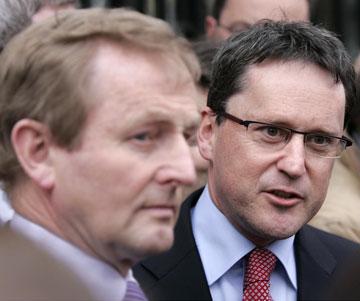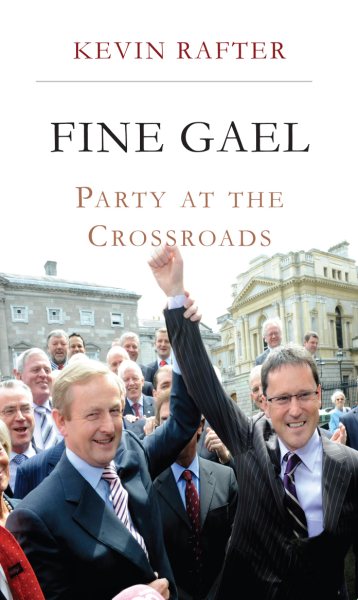Fine Gael: A Minor Miracle

By the end of May of 2002 Fine Gael was a political force on the verge of extinction. In the wake of its general election defeat the party had been left crushed. Twenty-three Fine Gael seats, including those of eleven members of its frontbench, were lost. Several of the party’s biggest names, such as Alan Dukes and Charlie Flanagan, fell in battle. Overall, Fine Gael got a dismal 22% share of the vote, its number of Dail seats was reduced to an atrocious 19% and it secured only three of the 47 available Dublin seats. It was the party’s poorest election result since 1948 and for many a sign that it was in terminal decline.
That Fine Gael has bucked this disastrous trend and recovered enough of its political clout to present a serious challenge Fianna Fail at the next election is a minor miracle. Kevin Rafter’s excellent new book Fine Gael: Party at the Crossroads uncovers the reasons for this amazing reversal in Irish politics. The book is many things: a detailed history of Fine Gael, a fascinating glimpse at the Machiavellian power games and clashing ideologies that have shaped the party over the last 80 years, and an informative biographical portrait of the man who has been at its helm during this momentous phase of resurrection, Enda Kenny.
The first thing Rafter explains is why Fine Gael, despite its identical values and roughly equal support base, has traditionally played second fiddle to Fianna Fail. His answers are clear and simple. The party has been consistently hampered by poor organization, a string of charmless leaders, an incapacity to tailor its policies to the real needs and concerns of the people, a hopeless inability to capitalise on its achievements, and, more recently, a public perception that it is old-fashioned and irrelevant.
As Kevin Rafter reminds readers, Fine Gael has already cheated death numerous times but the almost farcically catastrophic 2002 election result left its members in no doubt that huge changes were needed immediately. Ironically, the first of these was the reinstating of a key figure from the party’s past, the strategist and organisational head, Frank Flannery. It was he who delivered the damning report which bluntly stated that if Fine Gael did not adapt it would not survive. The Flannery Report’s ultimatum at last stirred the party into action.
Ultimately no brilliant ideas or original schemes have contributed to the revival in Fine Gael’s fortunes. In fact, the party’s last eight years have not so much been a regeneration as an overhaul. Many of the measures taken were painfully obvious and long overdue. An ongoing leaders tour, regional conferences, town-hall meetings, focus-group research, a swish website and billboard marketing have restored Fine Gael’s grassroots support. These strategies have partly been made feasible by the party’s decision to overturn its longstanding rule not to accept corporate donations.
Slower still was Fine Gael’s adoption of a new image. As the revelations of the Mahon tribunal continued to emerge and suspicion increased about the health of Bertie Ahern’s personal finances, Fine Gael repackaged itself as the party of honesty and integrity. It highlighted the corruption and inefficiency of the government, and pledged to end the squandering of public money. It also made good on the ‘rip-off republic’ perception of Ireland, and promised to foster a society of fairness and equality. Fine Gael has also proven to have a canny ability to conjure up high-profile candidates at pivotal moments, a policy that has paid dividends in the cases of Mairead McGuiness and George Lee’s sensational electoral victories.
What Kevin Rafter is more ambivalent about is the issue of leadership. For him Enda Kenny is “the man who came from nowhere”, a figure known and respected within the Fine Gael party for his tireless appetite for work, his ability to listen, and his great wit and charm. But Kenny was never considered a politician of any great potential by his colleagues and his sudden rise to FG leader took many of them by surprise. Rafter agrees with Michael Ring’s famous comment that Kenny has provided Fine Gael with a “nice fresh face” that “looks well on posters”, and he certainly has the all-important “affability factor” that Bertie Ahern had, and that every Fine Gael leader since Garrett FitzGerald has lacked. Rafter also commends Kenny for way in which he has healed the internal divisions that crippled Fine Gael and brought the party forward as a single united force.
In Kevin Rafter’s opinion, what has given Fine Gael its newfound strength is the fact that, following in the footsteps of Fianna Fail, it has become a ‘catch-all’ party without any ideology. It stands for nothing and therefore excludes no-one. And yet Rafter believes that this lack of a definite set of beliefs is exactly what continues to undermine Enda Kenny’s leadership and his chances of becoming Taoiseach. His party may be going from strength to strength, but almost every time Kenny has come within an inch of success in the Dail he has been let down by an apparent lack of conviction. Whether he can overcome this weakness and lead Fine Gael to victory is something we shall have to wait and see.

Fine Gael: Party at the Crossroads
By Kevin Rafter
237 pages
Published by New Island
EURO: 14.99
